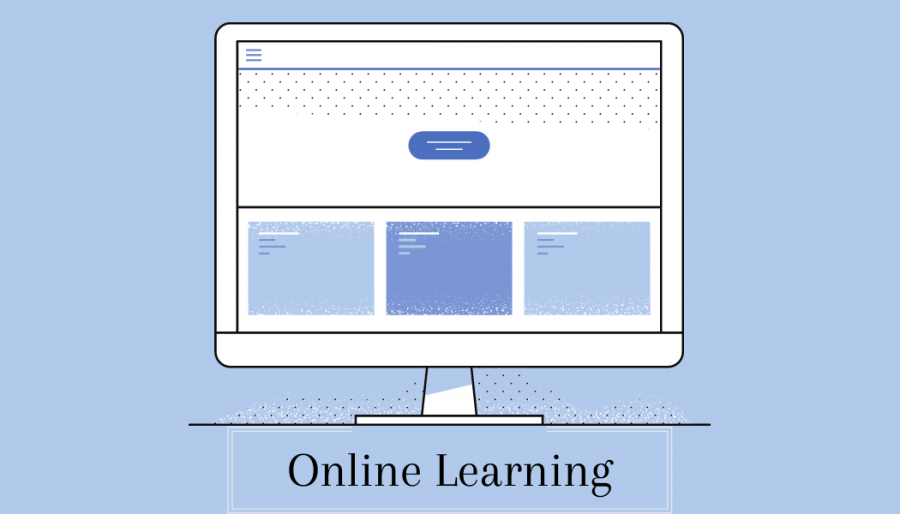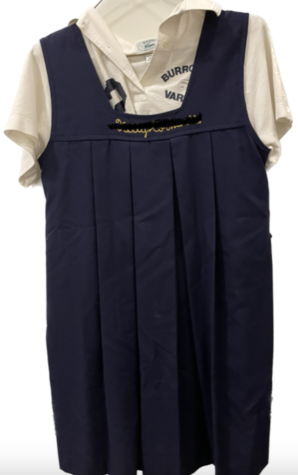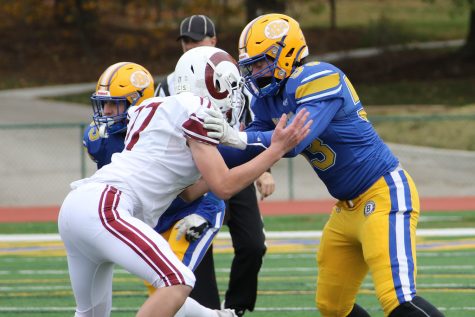Online Learning
April 22, 2020
Many of us are living through the first pandemic to dramatically affect our daily lives (no disrespect to H1N1), and we are all struggling to make do through these unprecedented times. With stay-at-home orders extending further and further and in some cases, indefinitely, many have adopted a pessimistic outlook regarding when we’ll be able to “return to normalcy.” Though we are all enduring strict isolation and social distancing guidelines, things are looking upwards. The stock market is finally beginning to recover, many of us are starting to acclimate to our prolonged hours indoors, and I think it’s safe to say we’re all welcoming the silver lining of this unfortunate situation: the godsent ability to catch up on TV shows and sleep. While it may be rather extreme to say that isolation is a “blessing in disguise,” we are all finding our way and the online learning situation is definitely improving. Seeing as I am writing in a school publication for members of the John Burroughs community, I figured that I should address how this has affected the JBS learning environment. I decided to ask Burroughs Department chairs about their experience with online teaching and how it has affected attendance, grading, and the classroom environment.
I think it goes without saying that for students, this is not an ideal situation. We don’t get to see our friends everyday, meet with teachers as often, and focusing at home might feel nearly impossible at times. We have firsthand experience with the difficulties of online school, and though thankful for the  opportunity to continue holding classes, many were discontent with the changes. Several responded by saying that they were glad to have Zoom classes, since the alternative would likely be assignments without any form of class meetings. “I think the Zoom classes allow us to make the best out of an unfortunate situation. As science teachers, we cannot do hands-on activities like we used to, so we are trying to be more creative with labs and active learning approaches,” said Dr. Winters, chair of the JBS Science Department. “I’m honestly grateful for the technology. Had this pandemic descended upon us when I was in high school (and I will not grant you the satisfaction of dating myself beyond that clue), we all would have been holed up at home, twirling the cord around our fingers, while we talked on an old fashioned landline. But now, I get to see all of my students a couple of times a week,” commented Ms. Gebhardt, English Department chair. While it may not be as great as being with our classmates and teachers on campus, online learning with Zoom seems to be about as good of an alternative as we could have asked for; we can still see each other face to face, and there are built-in whiteboard and screen-sharing options.
opportunity to continue holding classes, many were discontent with the changes. Several responded by saying that they were glad to have Zoom classes, since the alternative would likely be assignments without any form of class meetings. “I think the Zoom classes allow us to make the best out of an unfortunate situation. As science teachers, we cannot do hands-on activities like we used to, so we are trying to be more creative with labs and active learning approaches,” said Dr. Winters, chair of the JBS Science Department. “I’m honestly grateful for the technology. Had this pandemic descended upon us when I was in high school (and I will not grant you the satisfaction of dating myself beyond that clue), we all would have been holed up at home, twirling the cord around our fingers, while we talked on an old fashioned landline. But now, I get to see all of my students a couple of times a week,” commented Ms. Gebhardt, English Department chair. While it may not be as great as being with our classmates and teachers on campus, online learning with Zoom seems to be about as good of an alternative as we could have asked for; we can still see each other face to face, and there are built-in whiteboard and screen-sharing options.
However, despite Zoom’s versatility, the unfamiliarity, frustration, and awkwardness of the situation have all proven themselves to be adverse in many online classrooms. “First of all, I’ll be blunt: I hate online teaching. What I like best about teaching is literally being in my classroom with my students— chatting with them between classes, hearing them joke with each other and work together in small groups, the interactions as we work together as a community to build an understanding of complicated topics. With distance learning, I can ‘deliver instruction’ (via Zoom, videos, or sending practice problems) but I do not feel that I am ‘teaching.’ It’s much harder to read the room to sense if students are understanding a concept, and frankly, it’s less fun. I really miss the relational aspects of my job and the connections with the students and my colleagues,” reflected Math Department chair, Ms. Crowley. She was not the only department chair to comment upon this. “Even though the Zoom classes can be awkward, frustrating, and the communication is more difficult, I am glad to still be able to see and interact with my students a few times each week. I know all of the science teachers feel the same way,” mentioned Dr. Winters. “Zoom is awkward, the internet kicks us off calls, and I fumble my way through discussions using elaborate pantomime because glitches delay the conversations, but it’s better than the alternative,” said Ms. Gebhardt. Though it’s been difficult to conduct classes per usual or retain normal classroom discussion structure, some classes have been able to maintain their fundamental structure: “I think every teacher would tell you that they’d rather be in the room. I can sense body language and there’s a certain energy you feel in a classroom. It’s the reason we went into teaching in the first place; no one went into teaching to do this. That being said, if I were to record a ten minute session of the seniors’ bioethics class at school and asked you if it was from Zoom or from a classroom, I don’t think you’d be able to tell. I’d rather have that than nothing,” acknowledged Dr. Smith, History Department chair.
Besides the mutual unfamiliarity of the online classroom, some teachers shared how the transition has affected their classroom in numerous other ways, ranging from attendance to assessments. “I want to highly commend the students- I have had a super high percentage of on-time attendance and completion of work, and everyone seems to be taking it in stride. You guys have been understanding as your teachers have been on a really steep and unplanned learning curve ourselves,” commended Ms. Crowley. Whether it is due to the deprivation of human contact or the overabundance of free time, 7th graders and calculus students alike seem to be more punctual and prepared than ever. However, with over 600 students on their own schedules, with their own internet connections, and with variable levels of reachability via email, there have been a few exceptions. “Without a bell, it’s hard to keep everyone on the same time. I’ve been starting class a few minutes before the bell schedule says we should and people file in: some people are there waiting for me, some people come a few minutes after that, and some will say ‘Oh my last Zoom class ran late.’ Like everything else right now, you have to take it all with a heaping spoonful of toleration,” said Dr. Smith.
Classroom routine and assignments have changed to accommodate for distance learning, too. “Every habit, routine, and decision that I relied on from my years of experience are out the window, and I’m thinking anew about how best to reach my students,” disclosed Ms. Crowley. Dr. Smith also reflected on how he has adapted his history and bioethics classes: “I’ve moved to many more group assignments. I’ve tried to lock people down to a testing window. In a traditional history test, there’s no book, no notes, and it’s in a timed period; it’s just not feasible at this point in time. The way I decided to work around it was to create group assignments and ask ‘traditional thinking essay questions’ and just make sure everyone knows it’s open book and open note. Having the book and the notes doesn’t answer the question, though: you still have to do the thinking if I’ve asked the question right. It’s been successful so far and the essays I’ve gotten have been really thoughtful.” Luckily, essay and presentation-driven assignments have remained viable options during online learning.
Every habit, routine, and decision that I relied on from my years of experience are out the window.
— Mrs. Crowley
However, the classroom environment and general flow of discussion has been hampered due to the nature of distance learning. Dr Smith said, “I miss the socratic give-and-take. When a slide goes up on the board, I don’t want to be the one talking about every single bullet point up there. I want to be able to say ‘Okay, Rohan— you tell me about this!’ Now, I have to assume that role and go over everything in the screencasts and kick the big takeaway question to the Canvas discussion board. It’s something that can’t replace class, but it is something similar enough to make sure you know what’s going on.” Many teachers expressed that they have been able to simulate a classroom through Canvas discussions and Zoom classes, but that they’ll never be able to supplant the collaborative, discussion-based environment of the Burroughs classroom.
Though no one really prefers sitting alone and learning without the immediate assistance of teachers and peers, one thing is for certain. If we continue proper cooperation, we can make it out of this alright, and before we know it, we’ll be back to the proper John Burroughs School we all know and love. As I’ve tried to get a better understanding of what teachers think about online learning, one thing I’ve realized is that they all truly appreciate our adaptation and all of our efforts. Hang in there, students!










